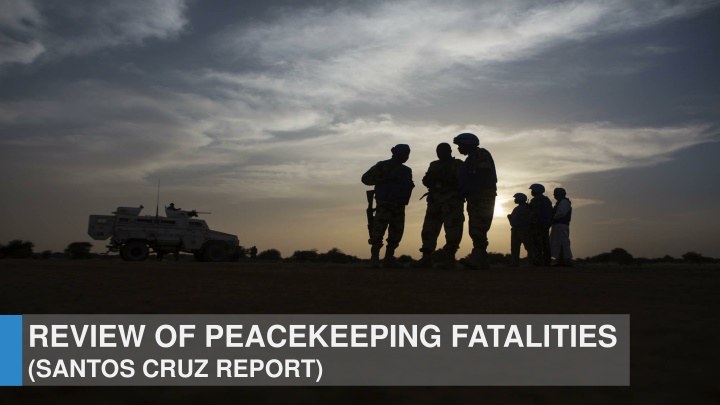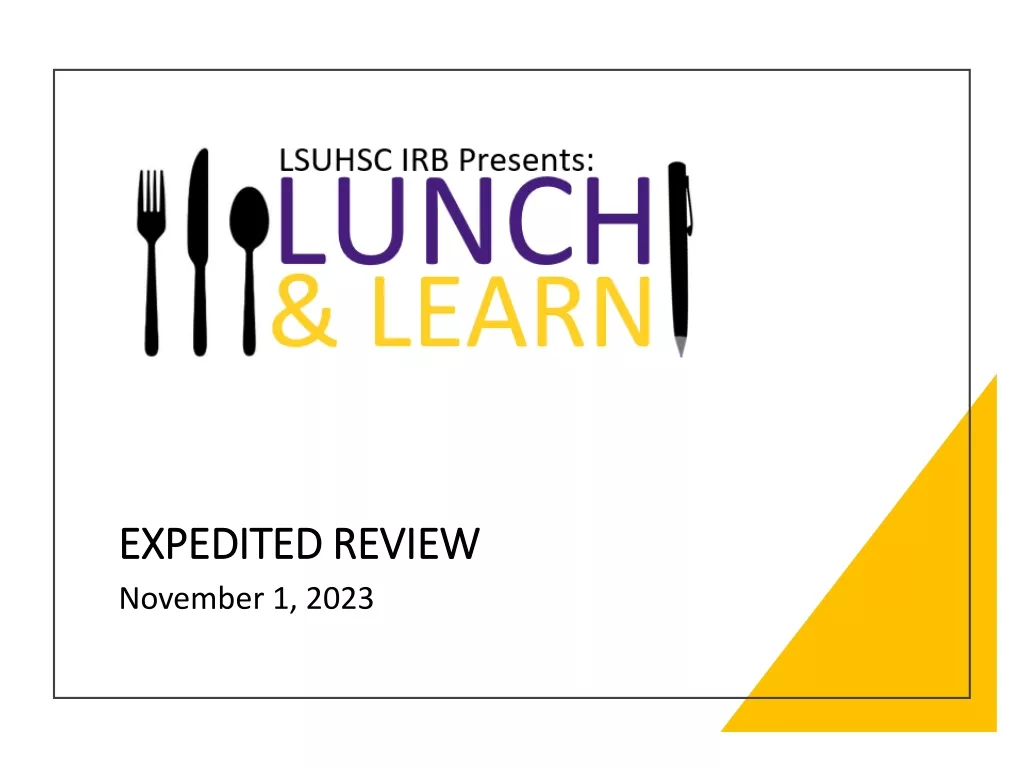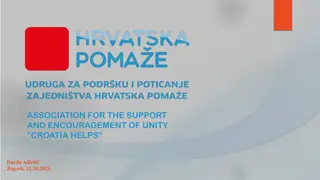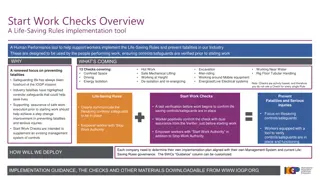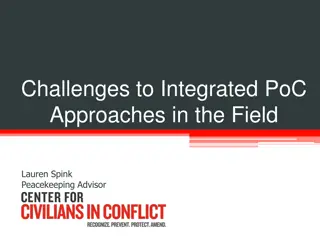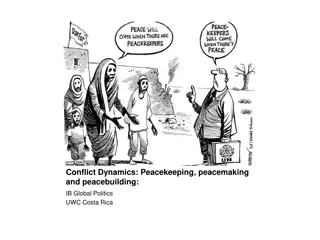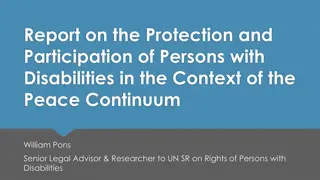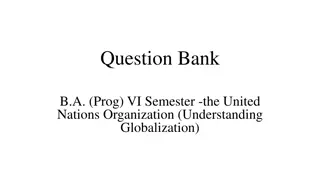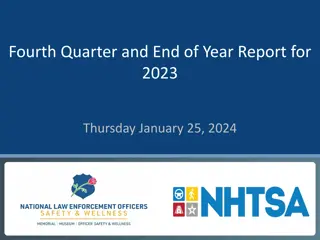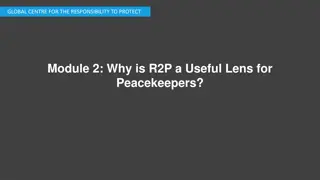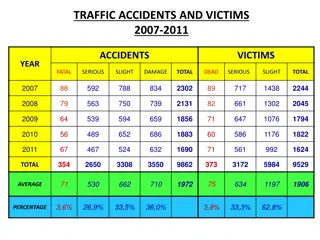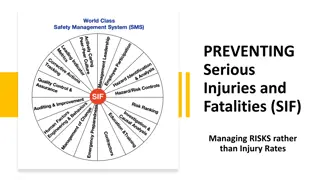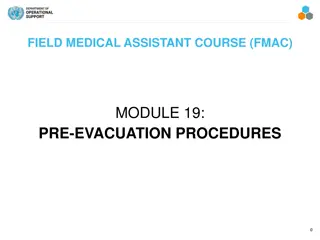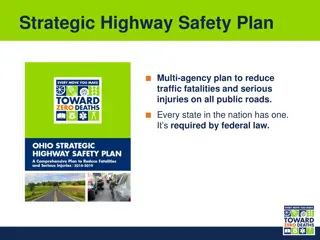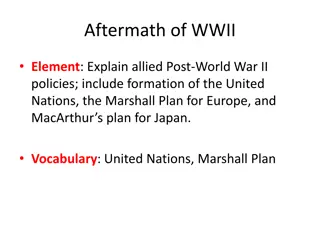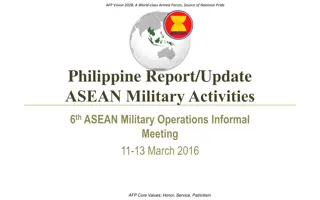Review of Peacekeeping Fatalities: Challenges and Solutions
The Santos Cruz report highlights the increasing fatalities in UN peacekeeping operations due to the failure to adapt to dangerous environments. The delegation formed to address this issue emphasizes the urgent need for the UN and Member States to take responsibility and implement necessary measures to ensure the safety of peacekeepers. With a focus on the high fatality rates in missions like MINUSMA, the report underscores the critical importance of immediate action to prevent further loss of personnel.
Download Presentation

Please find below an Image/Link to download the presentation.
The content on the website is provided AS IS for your information and personal use only. It may not be sold, licensed, or shared on other websites without obtaining consent from the author.If you encounter any issues during the download, it is possible that the publisher has removed the file from their server.
You are allowed to download the files provided on this website for personal or commercial use, subject to the condition that they are used lawfully. All files are the property of their respective owners.
The content on the website is provided AS IS for your information and personal use only. It may not be sold, licensed, or shared on other websites without obtaining consent from the author.
E N D
Presentation Transcript
REVIEW OF PEACEKEEPING FATALITIES (SANTOS CRUZ REPORT)
PEACEKEEPING FATALITIES WHY THE DELEGATION WAS FORMED
PEACEKEEPING FATALITIES WHY THE DELEGATION WAS FORMED Fatalities are rising in United Nations peacekeeping operations because the United Nations and the Member States are failing to adapt and take measures needed to operate securely in dangerous environments. SYNTHESIS If the United Nations and Troop/Police-Contributing Countries do not immediately take responsibility for reversing this trend, they will be consciously placing personnel in harm s way and compromising the mandates of peacekeeping operations. If we do not change, we will continue to be an easy target.
PEACEKEEPING FATALITIES 47% 86% MINUSMA HOLDS THE HIGHEST LEVEL IN PEACEKEEPING FATALITIES IN PEACEKEEPING HISTORY WITH 47% OF TOTAL FATALITIES (DECEMBER 2017) MINUSMA UNAMID MINUSCA MONUSCO 86% OF PEACEKEEPING FATALITIES WERE REPORTED IN AFRICAN MISSIONS (DECEMBER 2017) 168 91 PEACEKEEPERS LOST THEIR LIFE IN MALI DUE TO HOSTILE ACTS SINCE 2013 (DECEMBER 2017) 21 2 2 1 AFRICA ASIA MIDDLE EAST EUROPE SOUTH AMERICA 47% 15% 13% MINUSMA MINUSCA UNAMID
PEACEKEEPING FATALITIES 12 16 16 28 MINUSMA 17 23 22 14 2 4 2013 2014 2015 2016 2017 91 63 PEACEKEEPERS LOST THEIR LIFE IN MALI DUE TO HOSTILE ACTS SINCE 2013 (DECEMBER 2017) PEACEKEEPERS LOST THEIR LIFE IN MALI DUE TO NON HOSTILE ACTS SINCE 2013 (DECEMBER 2017) IED/MINES 43 18 DIRECT ATTACKS 7 17 AMBUSH 5 26 INCIDENTS FATALITIES 4 5 IDF
PEACEKEEPING FATALITIES STATUS OF PEACEKEEPING FATALITIES MILITARY 176 fatalities of military personnel, almost entirely in formed military units, comprised the vast majority (90.2%) of fatalities since 2013. MILITARY 176 UNPOL 9(5%) United Nations Police died, including 4 during ambushes of convoys and escort patrols, 1 in an attack on position and 4 from criminal acts. UNV NATIONAL STAFF 2 8 (4%) national civilians died, including 3 during ambushes on convoys and 5 while off duty. 8 NATIONAL UNV 9 UNPOL 2 (<1%) United Nations Volunteers (UNVs) died during terrorist attacks. No international civilian fatalities occurred.
PEACEKEEPING FATALITIES WHAT SHOULD THE UNITED NATIONS DO: CHANGING MINDSETS IMPROVING CAPACITY ACHIEVE A THREAT SENSITIVE MISSION FOOTPRINT ENHANCING ACCOUNTABILITY
PEACEKEEPING FATALITIES CHANGING MINDSETS - The United Nations must update the principles of peacekeeping to reflect that the blue helmet and flag do not offer natural protection, they are a target. This must be the mindset of all personnel, leadership, and T/PCCs in peacekeeping operations. - The United Nations and T/PCCs must plan operations based on threat assessment of the specific environment, not standards and policies better suited to traditional peacekeeping. - Peacekeepers must adopt a proactive posture in self-defence: they must take the initiative to use force to eliminate threats and end impunity for attackers by quickly organizing special operations. Bases must become a point of irradiating security. Overwhelming force is necessary to defeat and gain the respect of hostile actors. - Commanders must ensure that peacekeepers take basic precautions against common threats such as IEDs, ambushes, and camp/base protection - The United Nations should work to attract new T/PCCs, as they are normally receptive to a change in mindset
PEACEKEEPING FATALITIES IMPROVING CAPACITY - T/PCCs and the United Nations must ensure that pre-deployment training provides troops with the basic soldiering skills and environment- specific training needed to repel attacks and conduct operations against hostile elements. - The United Nations and battalion commanders must ensure sufficient in-mission training to ensure soldiers maintain their skills and adapt to the threat environment. - T/PCCs with high-quality technology, training and equipment should partner with and mentor other TCCs, and share information to enable operations against spoilers. - T/PCCs must deploy suitable contingent-owned equipment and ensure that it is maintained in-mission. The United Nations should update and adapt SURs to the threat environment. - The United Nations should generate intelligence capabilities that are well-suited to the environment, particularly low-tech solutions that generate tactical intelligence. - All mission components should focus more on human intelligence. - The United Nations must review and initiate efforts to rapidly equip troops with basic technology for improving security. - The United Nations and T/PCCs must ensure better medical training for personnel; generate and deploy embedded and mobile medical capacity; clarify and implementinclude medical personnel in operational planning. - The United Nations must invest in physical defence structures at camps, but these are no replacement for troops taking basic measures to defend the camp and take a proactive posture to turn the base into a point of irradiation of security.
PEACEKEEPING FATALITIES ACHIEVE A THREAT SENSITIVE MISSION FOOTPRINT - Missions must match their footprint at high-risk locations with the strategic objective of their presence there. - Missions should concentrate forces to solve security problems, re-tasking assets that are excess to operational needs in their current location towards active operations on spoilers
PEACEKEEPING FATALITIES ENHANCING ACCOUNTABILITY - United Nations leadership at all levels must be held accountable for failing to adapt to high-risk operational environments. - The United Nations should exercise the authority to say yes or no when evaluating pre-deployment preparation and performance in the field. The United Nations should refuse to deploy personnel that are unprepared for the threat environment, repatriate such personnel that are already deployed, and reject caveats that reduce integration and operational effectiveness needed for security
